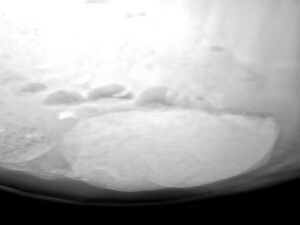–
Every breeder would like to see his or her foal grow up in health, but that is not always obvious. Foals can become ill from a wide range of bacteria, viruses and other conditions and sometimes the final diagnosis is not so obvious. Veterinarian Ids de Boer, for example, saw a Friesian colt, Tjitse, that was suffering from severe diarrhoea: ‘The owners of Tjitse are experienced breeders and thought that the diarrhea had to do with his mother’s heat, that happens more often. However, the diarrhea persisted, although the consistency of the manure varied somewhat’.
Good condition
De Boer examined the foal: Tjitse was in good condition and there were no abnormalities, apart from the diarrhoea. Deworming was done. Diarrhea can cause a foal’s condition to deteriorate rapidly, so it was important to address that first. Tjitse was given a paste to thicken the manure and another paste to help calm the intestines. Fortunately, this medication made a clear difference. Unfortunately, the manure remained too variable; the consistency varied from “cow pie” to almost normal, although there was often some manure water that came out before, during or after fattening.
acute colic
‘One morning, however, Tjitse had acute colic-like complaints; he often lay down and also regularly looked at his stomach. During the examination, the mucous membranes were good, the heart rate was slightly elevated and the bowel sounds were “too watery”. After having administered painkillers and intestinal relaxants, I immediately did a manure test at the clinic,’ explains De Boer. There was no worm infection going on, but there appeared to be a little sand in the manure.
Foals rarely have problems with sand
He continues: ‘Compared to adult horses, we rarely see sand problems in foals, so that wasn’t the first thing that came to my mind as the cause’. To get a good idea of the amount of sand in the gastrointestinal tract, an X-ray was made of Tjitse’s abdominal cavity at the clinic. It became obvious that there was indeed an enormous amount of sand in the large intestine, the cause of the colic and diarrhea. The sand often makes the manure too watery, because the sand rubs and irritates the mucous membranes of the gastrointestinal tract. The sand also blocks a reasonable surface of the intestines, so that the absorption of water is less optimal.

Check manure
The owners had not noticed, but Tjitse will secretly eat sand outside in the paddock and/or meadow. At the owners home, the passage to the meadow is a paddock with a sandy bottom, this is normally open. Now they were going to close this passage. In addition, Tjitse continued to get his pastes and he also received some slobber with psyllium (flea seed) every day to stimulate the sand drainage from the intestines. De Boer: ‘Fortunately, the manure was fully normalized within two weeks. The owners still regularly checked the manure, it turned out that there was no or minimal sand to be found’.
Read the full practical story of Drs. Ids de Boer in Phryso August
–

